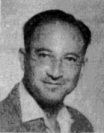Name Stan Frankel Role Physics researcher | Died May 1978 | |
 | ||
Stanley Phillips "Stan" Frankel (1919 – May, 1978) was an American computer scientist. He was born in Los Angeles, attended graduate school at the University of Rochester, received his PhD in physics from the University of California, Berkeley, and began his career as a post-doc student under J. Robert Oppenheimer at University of California, Berkeley in 1942. Frankel helped develop computational techniques used in the nuclear research taking place at the time. He joined the theoretical division of the Manhattan Project at Los Alamos in 1943. While there, he organized teams of persons (known as "computers") using electromechanical calculators to divide the massive calculations required for the project into manageable assembly line groups. Even that proved too slow, and Frankel turned to IBM tabulating machines to help process the numbers. This research led to his interest in the then-dawning field of digital computers. In August 1945, Frankel and Nick Metropolis traveled to the Moore School of Engineering in Pennsylvania to learn how to program the ENIAC computer. That fall they helped design a calculation that would determine the likelihood of being able to develop a fusion weapon. Edward Teller used the ENIAC results to prepare a report in the spring of 1946 that answered this question in the affirmative.
Contents
After losing his security clearance (and thus his job) during the red scare of the early 1950s, Frankel became an independent computer consultant. He was responsible for designing the CONAC computer for the Continental Oil Company during 1954–1957 and the LGP-30 single-user desk computer in 1956, which was licensed from a computer he designed at Caltech called MINAC. The LGP-30 was moderately successful, selling over 500 units. He served as a consultant to Packard Bell Computer on the design of the PB-250. His last computing project was the SCM Marchant Cogito 240SR electronic calculator introduced in 1965.
Scientific papers
Frankel published a number of scientific papers throughout his career. Some of them explored the use of statistical sampling techniques and machine driven solutions. In a 1947 paper in Physical Review, he and Metropolis predicted the utility of computers in replacing manual integration with iterative summation as a problem solving technique. As head of a new Caltech digital computing group he worked with PhD candidate Berni Alder in 1949–1950 to develop what is now known as called Monte Carlo analysis. They used techniques that Enrico Fermi had pioneered in the 1930s. Due to a lack of local computing resources, Frankel travelled to England in 1950 to run Alder's project on the Manchester Mark 1 computer. Unfortunately, Alder's thesis advisor was unimpressed, so Alder and Frankel delayed publication of their results until 1955, in the Journal of Chemical Physics. This left the major credit for the technique to a parallel project by a team including Teller and Metropolis who published similar work in the same journal in 1953.
In September, 1959, Frankel published a paper in IRE Transactions on Electronic Computers proposing a microwave computer that used travelling-wave tubes as digital storage devices, similar to, but faster than the acoustic delay lines used in the early 1950s. Frankel published a paper on measuring the thickness of soap films in the Journal of Applied Physics in 1966.
Publications
Frankel, S Phillips, “Elementary Derivation of Thermal Diffusion,” Physical Review, Volume 57, Number 7, April 1, 1940, p 661.
Frankel, S and N Metropolis, “Calculations in the Liquid-Drop Model of Fission,” Physical Review, Volume 72, Number 10, November 15, 1947, p 914-925.
Frankel, Stanley P, “Convergence Rates of Iterative Treatments of Partial Differential Equations,” Mathematical Tables and Other Aids to Computation, Volume 4, 1950, p 65-75.
Frankel, S P, “The Logical Design of a Simple General Purpose Computer,” IRE Transactions on Electronic Computers, March 1957, p 5-14.
Frankel, S P, “On the Minimum Logical Complexity Required for a General Purpose Computer,” IRE Transactions on Electronic Computers, December 1958, p 282-284.
Frankel, Stanley P, “A Logic Design for a Microwave Computer,” IRE Transactions on Electronic Computers, September 1959, p 271-276.
Frankel, Stanley P and Karol J Mysels, “On the ‘Dimpling’ During the Approach of Two Surfaces,” Journal of Physical Chemistry, Volume 66, January 1962, p 190-191.
Frankel, Stanley P and Karol J Mysels, “Simplified Theory of Reflectometric Thickness Measurement of Structured Soap and Related Films,” Journal of Applied Physics, Volume 37, Number 10, September 1966, p 3725-3728.
